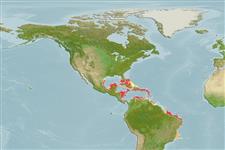>
Perciformes/Serranoidei (Groupers) >
Liopropomatidae (Painted basslets) > Liopropomatinae
Etymology: Liopropoma: Greek, leio = smooth + Greek, pro = in front of + Greek, poma, -atos = cover, operculum (Ref. 45335).
Eponymy: This is an acronym made up of the initial letters of an institution: Caraibisch Marien-Biologisch Instituut. [...] (Ref. 128868), visit book page.
More on author: Randall.
Environment: milieu / climate zone / djupintervall / distribution range
Ekologi
marina revassocierade; djupintervall 15 - 70 m (Ref. 9710). Tropical; 27°N - 21°S
Western Atlantic: Florida Keys, USA and Bahamas to northern South America.
Size / Vikt / Age
Könsmognad: Lm ? range ? - ? cm
Max length : 6.0 cm TL hane/ej könsbestämd; (Ref. 9710)
Taggstrålar i ryggfenan (totalt) : 6 - 7; Mjukstrålar i ryggfenan (totalt) : 12 - 13. Head, body, and caudal fin alternately striped with yellow-orange and lavender, these stripes separated by red lines (Ref. 13442).
Body shape (shape guide): fusiform / normal.
Found in the recesses of coral reefs. Secretive (Ref. 9710).
Life cycle and mating behavior
Könsmognad | Reproduktion | Lek | Ägg | Fecundity | Larver
Robins, C.R. and G.C. Ray, 1986. A field guide to Atlantic coast fishes of North America. Houghton Mifflin Company, Boston, U.S.A. 354 p. (Ref. 7251)
IUCN Red List Status (Ref. 130435: Version 2025-1)
Threat to humans
Harmless
Human uses
Verktyg
Special reports
Download XML
Internet-källor
Estimates based on models
Preferred temperature (Ref.
123201): 24.2 - 28, mean 26.8 °C (based on 124 cells).
Phylogenetic diversity index (Ref.
82804): PD
50 = 0.5000 [Uniqueness, from 0.5 = low to 2.0 = high].
Bayesian length-weight: a=0.01122 (0.00514 - 0.02450), b=3.04 (2.87 - 3.21), in cm total length, based on all LWR estimates for this body shape (Ref.
93245).
Trofisk nivå (Ref.
69278): 3.5 ±0.6 se; based on size and trophs of closest relatives
Fishing Vulnerability (Ref.
59153): Low vulnerability (10 of 100).
🛈
